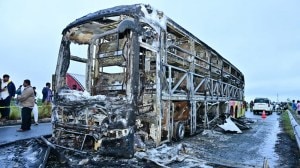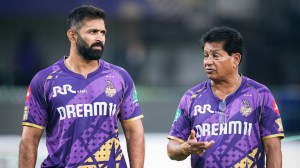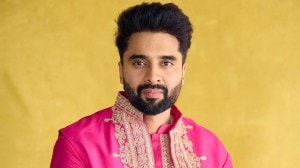Look beyond the picture-postcard
In the past Nepal was only known as a popular tourist destination with quaint traditions, thousands of festivals, exquisitely carved temples...

In the past Nepal was only known as a popular tourist destination with quaint traditions, thousands of festivals, exquisitely carved temples, beer-guzzling gods, blood-thirsty goddesses, and even living goddesses, in exquisite natural beauty.
There was peace everywhere and for the tourist if this did not appear as heaven on earth then what was? There were two chief reasons for the apparent peace: a) the King ruled with an iron hand; and b) the common were deprived of education to such an extent that they lived in blissful ignorance of their own rights. The few revolutionary leaders that we had in the 1980s were either underground or serving life sentences (including one of the ministers that the King has recently appointed). Other leaders that we read about these days were doing 9 to 5 jobs; others had just returned after decades in exile in India. The only place where some kind of public gathering, of the anti-monarchy type, was allowed was at my grandfather’s place, in Kathmandu, ostensibly to celebrate his birthday.
Almost all the leaders of the democratic parties, which were banned then, as well as the members of the ruling Panchayat Party, would attend his birthday. It would also be the only yearly opportunity to make mild inflammatory speeches against the King’s regime in public domain. The fear factor of getting interned by showing even an iota of anti-monarchy feelings was incredibly high amongst the handful of our educated lot. A family friend had his house behind the King’s heavily barricaded palace. Occasionally, the late King Birendra’s youngest brother, Dhirendra, would walk past his house early morning. So our man decided to keep garlanded pictures of the King and Queen in his front porch to show his obeisance. The same gentleman would insist on checking if all the windows of our house were closed or not if it involved talks of Panchayat regime. ‘‘Who knows somebody might be eavesdropping on me and others,’’ he would reason. The fear of imprisonment on the slightest hint of opposition was very much real.
The 90 per cent poor and often uneducated lot were invisible to the world except for those rare occasions when their face would get arrested in photographs. The world could then view them in postcards, personal pictures, books and the few documentaries made, with the picturesque landscape of undulating terrains and snow-capped mountains as the background. A close-up picture of the face would show the scars of hard life and the exploding population in the 1980s was only making things worse. By 1991, according to the World Bank, 5 per cent Nepalese owned 40 per cent of the cultivated land; 45 per cent of the peasantry was landless; 9 out of 18 million did not even have basic needs of life. The land reforms initiated by King Mahendra (King Gyanendra’s father) had turned into a total failure. If anything, land got even more concentrated amongst the elite few zamindars. People knew that they had a King and thought the King provided them everything. ‘‘Everything is given by the King to us, this road we are walking on today, this electricity pole, everything. Everything belongs to the King,’’ Gokul told me with pride when I tried to reason with him that the country belongs to us all.
Beyond the outskirts of the Kathmandu valley the elderly ones often only knew that there was a king, but did not even know his name. There was only one power centre in the nation prior to 1990, and that was the Palace. From this power centre others in the royal family, blood-relatives, Panchayat hardliners, military generals (mostly Rana blood-cousins to the Shahs) and the powerful secretaries to the King, drew their power and fabulous wealth. While each of their children was gifted palaces as wedding gift, the Gokuls and Maus lived their poverty-stricken existence. But by the mid-1980s our world too had begun to change. Television arrived in the mid-80s. The ranks of educated people aware of their rights began to swell. The speeches became open, brazen and fiery. Then India blockaded Nepal, and the King’s weakness got exposed. Democracy came, but the fruits did not filter down the ranks.
However, it gave rise to a new order of educated people comprising journalists, lawyers, voluntary organisations and NGOs who have taken up the political aspirations of the common. The harbinger of the awakening of the consciousness of the poor however was the Maoist uprising that started in 1996. It gave a clarion call to the poor of the entire nation to rise up and fight for their rights. The then democratic regime responded brutally, and this laid the foundation of the internecine feud that has swallowed the country. In 2002 the country got to know that the constitution framed in 1990, after democracy came, and which was supposed to have enshrined sovereignty in the hands of the people, was a lame duck one. Using some of the grey areas of the constitution King Gyanendra started a process in 2002 that has now culminated in an absolute monarchy. The Nepali people have now lost their sovereignty. It’s enshrined in the King’s crown now. He stands tall above all human laws as the supreme arbiter. If he wants he can do us good, if he wants he can be as evil as an evil person can be. We are at his complete mercy. With such unlimited power, that he now has by the privilege bestowed upon him by his birthright, the King is raring to go. All the Panchayat hardliners, of his father’s and brother’s time, have been called back to render their services to the crown. After 14 years of wilderness their past glory and power is now again restored, regardless of their sordid past and history. They have vowed to restore Nepal back to her halcyon days, as they knew it, when everything appeared so peaceful, without the accompanying freedom. It only requires shedding the cheap blood of the soldiers of the Royal Nepal Army and the Maoists and several times that number of those caught in the crossfire of Indian and American bullets. And then there shall be peace, without any freedom. Or will it?
The writer likes to be identified as an activist






- 01
- 02
- 03
- 04
- 05

























